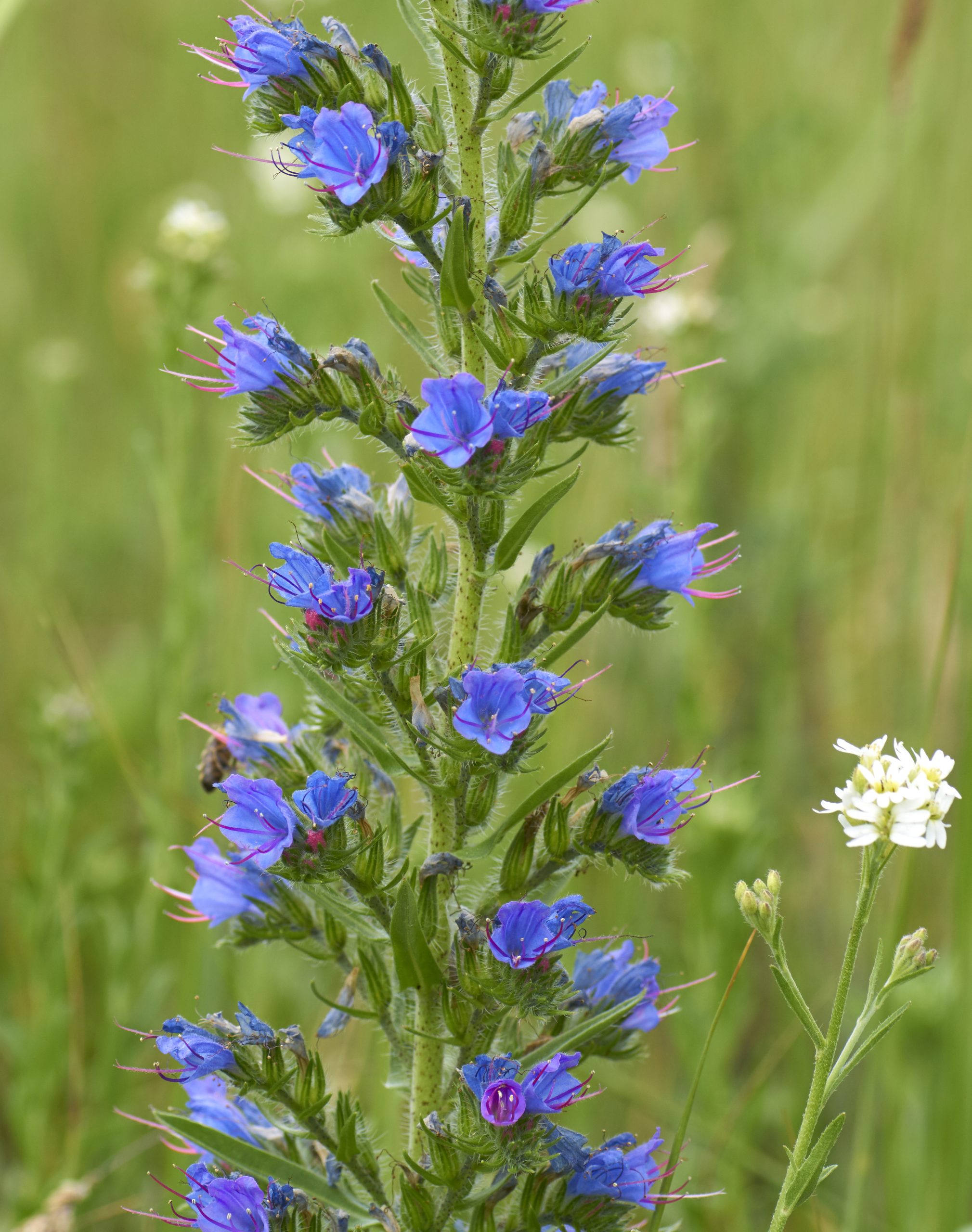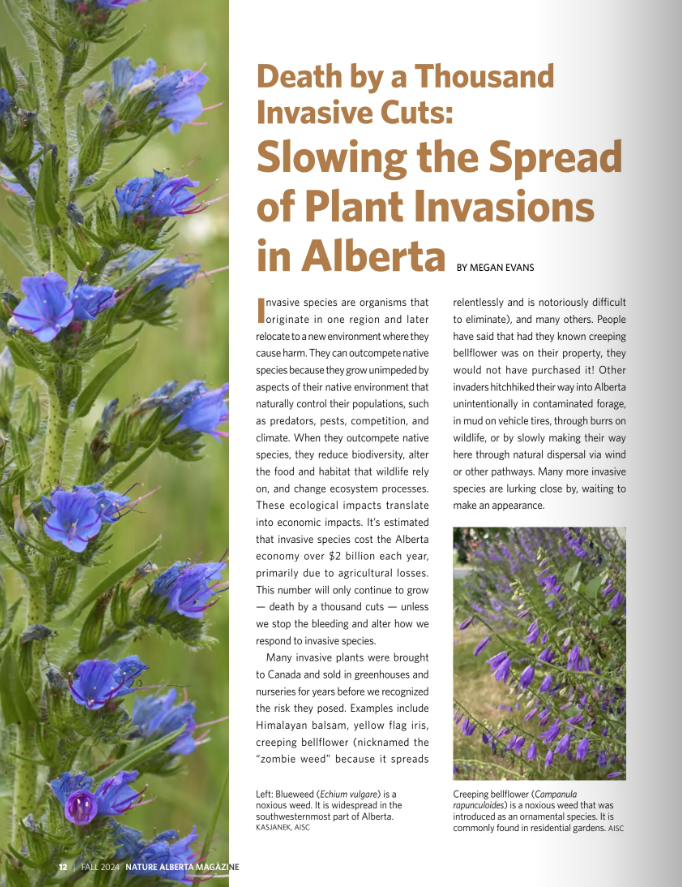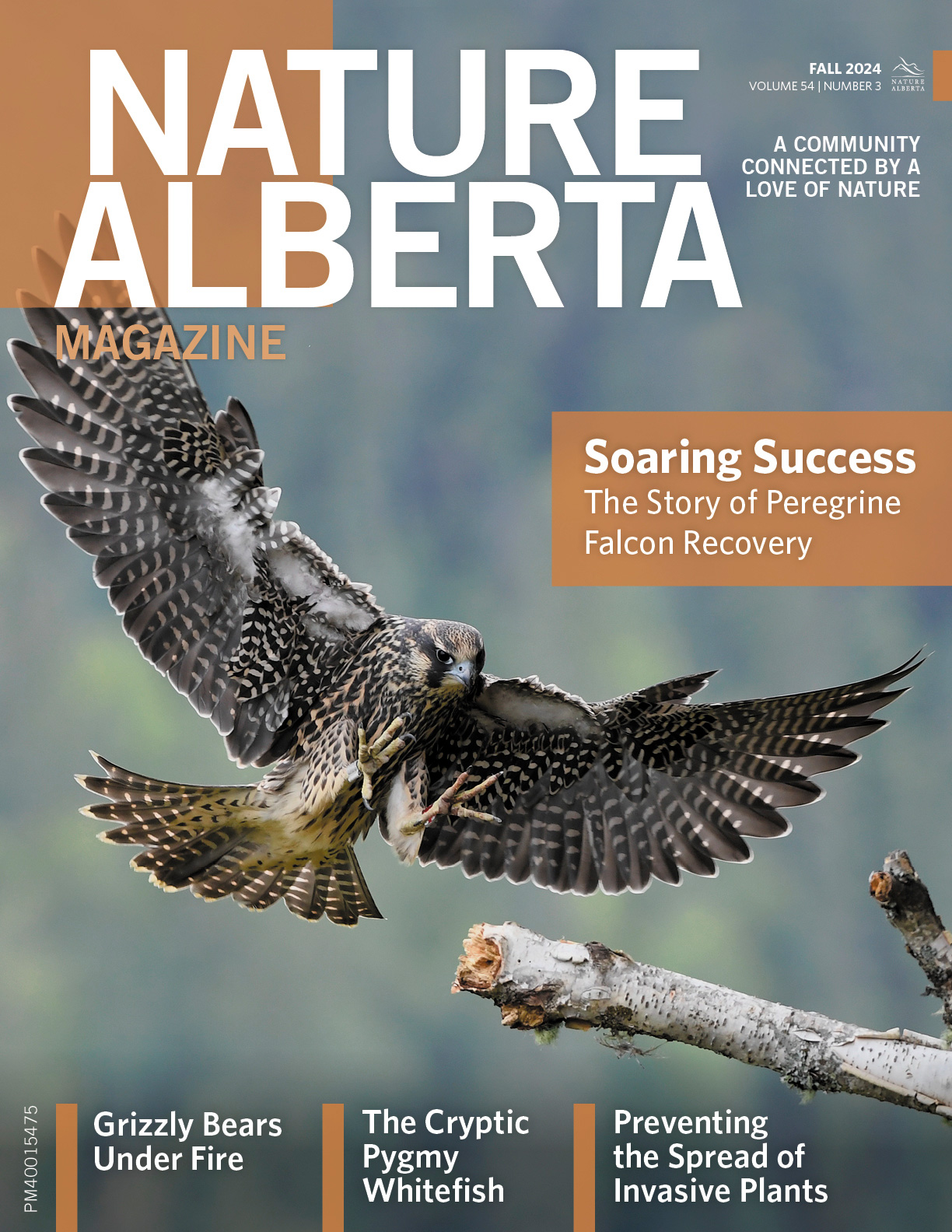Death by a Thousand Invasive Cuts: Slowing the Spread of Plant Invasions in Alberta
18 October 2024

By MEGAN EVANS
Invasive species are organisms that originate in one region and later relocate to a new environment where they cause harm. They can outcompete native species because they grow unimpeded by aspects of their native environment that naturally control their populations, such as predators, pests, competition, and climate. When they outcompete native species, they reduce biodiversity, alter the food and habitat that wildlife rely on, and change ecosystem processes. These ecological impacts translate into economic impacts. It’s estimated that invasive species cost the Alberta economy over $2 billion each year, primarily due to agricultural losses. This number will only continue to grow — death by a thousand cuts — unless we stop the bleeding and alter how we respond to invasive species.
Many invasive plants were brought to Canada and sold in greenhouses and nurseries for years before we recognized the risk they posed. Examples include Himalayan balsam, yellow flag iris, creeping bellflower (nicknamed the “zombie weed” because it spreads relentlessly and is notoriously difficult to eliminate), and many others. People have said that had they known creeping bellflower was on their property, they would not have purchased it! Other invaders hitchhiked their way into Alberta unintentionally in contaminated forage, in mud on vehicle tires, through burrs on wildlife, or by slowly making their way here through natural dispersal via wind or other pathways. Many more invasive species are lurking close by, waiting to make an appearance.
Dealing with the Threat
The main approach we use to manage invasive plants is the Alberta Weed Control Regulation (currently under review). There are 75 invasive plants listed in the Regulation, including some that are not yet present in Alberta but are included to facilitate early detection and rapid response should they arrive. Landowners are required to manage these listed species, and non-compliance can result in control work that is billed to them. In addition, there are unregulated plants that, while beneficial in some circumstances, can be as invasive and damaging as the regulated species. Why aren’t those species regulated? Well, it’s complicated…
Consider lawn grass. A common species is Kentucky bluegrass, desired by many homeowners because it can provide a classic vibrant green lawn. (Let’s talk about reconsidering lawns some other time!) The problem is, when species like Kentucky bluegrass make their way to natural areas, they slowly invade, gaining ground each year and outcompeting native species. It’s the same story with many agronomic species that are seeded in pastures for hay production, such as Timothy, smooth brome, and cicer milkvetch. These species are great for producing forage, but when they are inevitably introduced to native grasslands they invade just like lawn grass.
There are also horticultural species that are problematic. Take Russian olive; this tree is incredibly invasive in drier areas of the province, where it can completely take over riparian areas and is difficult to control. If you’re a gardener, you’re likely aware that species like goutweed and lily of the valley, all commonly found in garden centres, are incredibly aggressive and will take over urban gardens, becoming a burdensome nuisance for years.
What about dandelions? There’s nothing dandy about them! Dandelions were removed from Alberta’s list of regulated species in 2010, but not because they are no longer a threat. It’s actually the opposite. Dandelions have become so widespread and abundant in Alberta that they are too onerous to regulate and enforce. Opinions about how to deal with dandelions are mixed. Some people encourage leaving dandelions in urban yards because they provide an important early source of food for bees. But do you know what is a much better source of food for our native bees? The native wildflowers they evolved with! It’s hard to justify encouraging the growth and proliferation of dandelions when we know they are aggressive invaders of natural areas. As such, they pose a risk to what all our native bees and other native species fundamentally need: native plants.
Once invasive plants have become established in an area, the best approach for managing them is integrated pest management. The first step is to properly identify the species present and document their distribution and abundance. It is also important to know the mode of reproduction (e.g., seeds and/or underground creeping roots, etc.) and life cycle (annual, biennial or perennial) for each species. Control should be implemented using a tailored approach that best addresses the characteristics of each plant. For example, for a biennial that has flowered or gone to seed, manually bagging and landfilling the seed is effective; whereas for creeping rooted perennials, the seed production and the creeping roots both need to be targeted through measures that may include manually pulling, mowing, and/or herbicide application. Locations where invasive plants have been controlled also require follow-up monitoring. It often requires many years to verify that there is no new vegetative growth or germination of seeds in the soil. Managing invasive plants is a long-term endeavour; it’s costly, challenging, and complex. And there is no silver bullet.
Prevention Is Key
An ounce of prevention is worth a pound of cure, and the biggest bang for our buck is preventing introductions in the first place. We could shrink the overall cost of invasive plant management by directing more effort to prevention, early detection, and rapid response to new invaders. Yet, ironically, this is where we invest the least. In the invasive species world, our successes are invisible and our failures are everywhere. Consequently, preventative measures are often a hard sell. We tend to wait until damage becomes apparent before acting, instead of investing heavily in prevention.
Prevention strategies need to be implemented at multiple levels. We need to focus on preventing new invaders to Alberta, new invaders to municipalities (that might be present in other parts of Alberta), and new invaders to individual yards. To do this, Albertans need to be aware of the dangers of invasive plants and be able to identify and report them. Images of wild boar, zebra mussels, crayfish, and spongy moth often foster unease. But for most, a field of oxeye daisies is not scary at all; it may even appear to be an improvement over what was there initially. We have more work to do to convince the public that there is a difference between wildflowers and weeds, and that everyone has a role to play in preventing their introduction and spread.
Despite the aforementioned challenges, Alberta continues to be a leader in invasive species management. We are the world’s largest rat-free jurisdiction and we have robust legislation overseeing the regulation and management of species. Nevertheless, given the current rate of spread, we need to do more.
How You Can Help
The good news is there are actions we can all take to be a cut above the rest and prevent the introduction and spread of invasive plants.
- Spread the word, not the weed! Commit to talking to one other person about this issue and encourage them to adopt the following practices to prevent introductions and spread.
- Come clean and leave clean! Simple practices such as cleaning boots, gear, and vehicles when moving between areas can prevent the introduction and spread from “hitchhikers” that might otherwise tag along.
- Be “Plant Wise!” When at plant swaps and other events, scrutinize plants that readily spread and require no maintenance. Make sure to read seed packets and check for regulated species.
- Be proactive! Assess your property for invasive plants. Determine which species are eradicable and use an integrated pest management approach to controlling new invaders.
- Learn to identify and report invasive plants. There are lots of resources available, including plant guides and apps. The Alberta Wildflowers app lists thousands of native plants and many invasive plants as well. It has an easy-to-use interactive key that will help you narrow down what you are looking at. The Early Detection and Distribution Mapping System (EDDMapS) app covers all the regulated invasive species and a few others with photo galleries, descriptions, and distribution maps all built in. Reports of invasive species that are submitted through EDDMapS are verified (using the photos you submit) and sent to the local authority for follow-up and can be used without cell service. This is a particularly great resource if you find invasive plants when hiking, camping, or visiting natural areas.
- You’ll find a wealth of informative resource and practical tips on the Alberta Invasive Species Council (AISC) website, abinvasives.ca. Sign up for the newsletter to stay in touch and up to date on all the latest invasive species news and developments. You can also support AISC’s work and connect with a like-minded community by becoming a member.
With your help and these simple actions, we can protect Alberta from the impacts of invasive species!
Megan Evans is a terrestrial ecologist with over ten years in the field. She is passionate about protecting biodiversity, especially our native plants and pollinators. She contributes to those efforts through her work as the Executive Director of the Alberta Invasive Species Council and as the President of the Alberta Native Bee Council.
Read the Original Article for this Post
For a richer reading experience, view this article in the professionally designed online magazine with all images and graphs in place.
This article originally ran in the Fall 2024 issue of Nature Alberta Magazine (Vol. 54 | No. 3).


